The Chinese Mantis (Tenodera sinensis) is one of the most popular pets amongst the Mantid species. They’re big, easy to take care of, and easy to find, which makes them readily available for people who want to keep one as a pet.
Also, just like many other mantis species, they’re a fantastic sight of elegance and power. They have a very strong feeding response which makes them very interesting to observe. If you’re interested in getting a Chinese Mantis for your collection, here’s everything you need to know about them!
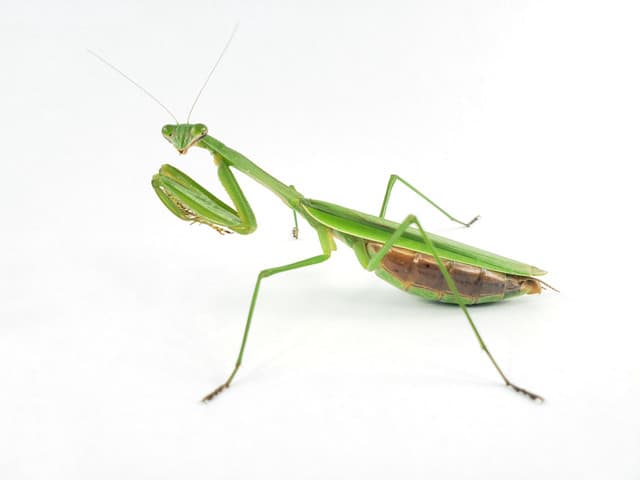
Chinese Mantis Care Sheet
| Name of species | Tenodera sinensis |
| Family | Mantidae |
| Common name | Chinese Mantis |
| Category | Mantis |
| Type | Macropterous |
| Native location | Asia and North America |
| Temperature | 70F° to 80F° |
| Humidity | 55% to 65% |
| Size | 4 to 5 inches (10 to 12.7 cm) |
| Diet | Insects and small vertebrates |
| Lifespan | 8-12 Months |
| Experience level | Beginner |
Chinese Mantis Overview
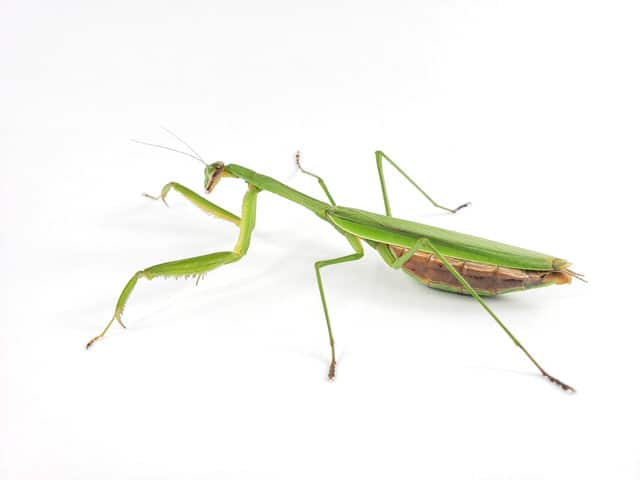
The Tenodera sinensis is commonly known as the Chinese Mantis. It’s considered Macropterous, which means it has long wings that it uses for flying.
It’s widespread throughout Asia and its surrounding islands, but you may also find them in North America.
They’ll feed on any insect they can catch, such as cockroaches, larvae, and worms, but they’re also known for eating small lizards and even hummingbirds when they get the chance.
Appearance & Variations
The Tenodera sinensis has the classic appearance of any Mantis. It has a long and slender body, a slightly bulkier abdomen, and two bent front legs in front of its body that they use to defend itself and catch prey.
The Chinese Mantis can display a wide range of colors from bright green to brown, but the shape of the abdomen always resembles a leaf.
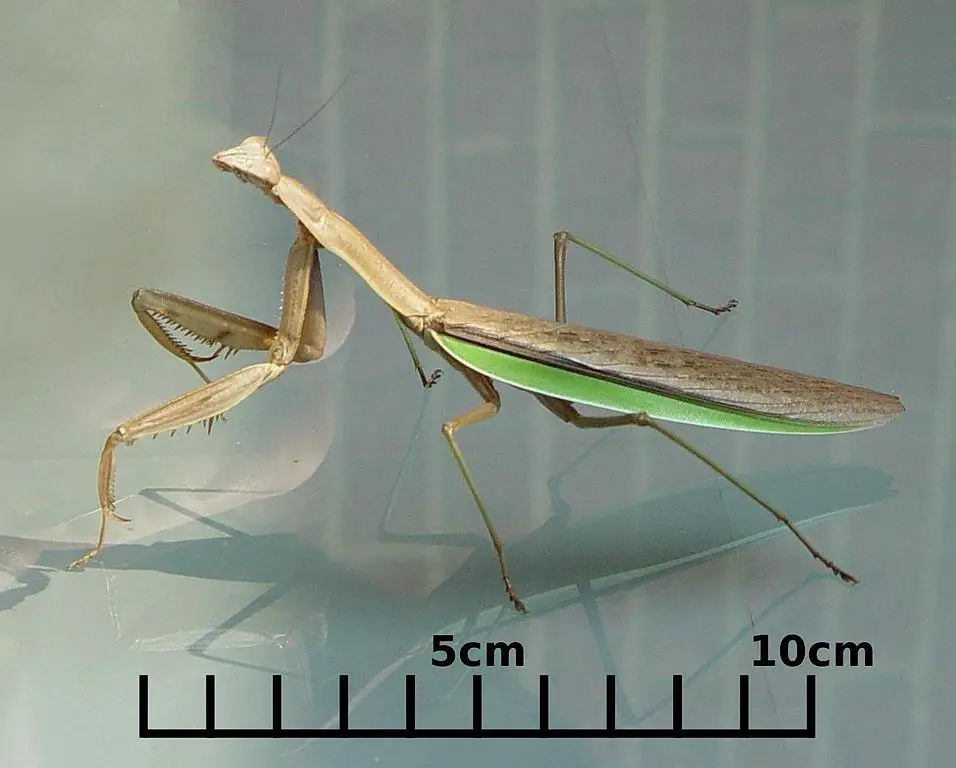
They also have functional wings they can bring out from their thorax, but only males can use them to fly adequately.
As a species, the Chinese Mantis exhibits sexual dimorphism, with the females being larger than the males. Females typically top out at a size of around 5 inches, which is quite large for a mantis. Males also have longer antennas and wings, with eight segments in their abdomen, while a female’s abdomen has only six segments.
Price
The Chinese Mantis is easy to find and buy online. A captivity-bred adult will go for around $20, so it’s not an expensive pet.
You may be interested in purchasing a nymph to ensure that the specimen you buy lives as long as possible with you, but they’re slightly more costly and will be harder to take care of.
Therefore, you might want to consider getting an adult first before getting a nymph unless you’re experienced with caring for insects.
Behavior and Temperament
The Chinse Mantis has many possible temperaments, from curious to meek, but they’re primarily calm and peaceful.
They’ll feed on any insects in their environment, including other specimens of their species, so you shouldn’t keep them in communal enclosures.
They’re also fun to see when hunting and eating, so feeding time is never boring with a Chinese Mantis. Despite them being voracious feeders, these insects are harmless to humans. They aren’t venomous and can’t harm you, so you can handle them if you’re careful.
If you want to handle a CM, there are some precautions you should take. First of all, they may get stressed, so be careful not to excite them too much.
They’re fragile, so be careful not to crush them as they get injured easily. They’re particularly vulnerable up to four days after a molt, so make sure you don’t handle them during that time.
Caring for a Chinese Mantis
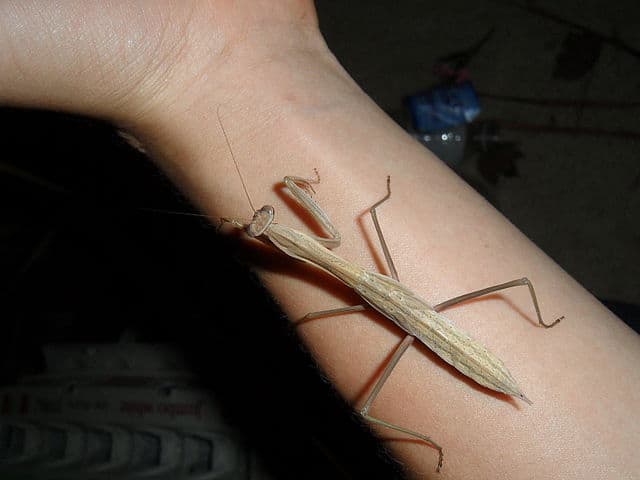
Temperature and Humidity
The Chinese Mantis is used to tropical climates, so they’re most comfortable with high temperatures and humidity.
An enclosure with around 70F° to 80F° is ideal for them, and the humidity should be between 55% and 65%.
Substrate
The Tenodera sinensis doesn’t need too much substrate as they’re not burrowers, so around two inches of substrate will be enough.
As for the substrate composition, mixtures with Peat Moss are ideal since this insect thrives in humid environments, which the moss can help maintain.
Tank
The CM needs an enclosure with excellent ventilation to avoid mold formation. It’s also essential to provide them with a light source if you intend to keep them in a dark room; however, if they get at least twelve hours of sunlight each day, this isn’t needed.
The tank should be at least two times as wide and three times as long as the CM, but ideally, it would be larger than this to allow for more decorations and range of movement.
As for decoration, you should always add at least one twig or branch to enable the CM to climb it and hang from there. Moreover, decorative elements such as fake (or real) plants, artificial foliage, and thin vines will also add to the tank’s decoration and the comfort of the mantis.
Watering
The CM is most comfortable in a humid environment, so you should mist the substrate with water every two or three days to keep it moist but not wet.
They don’t need a water dish as they’ll get most of their hydration from their food. However, they’ll also get their hydration from droplets in the branches or decorations, so it’s important to mist the enclosure regularly to ensure that they have enough access to water.
If you want to be on the safe side, you can also provide them with a small water bowl. Something like a bottle cap filled with water is small enough to prevent them from drowning but does allow them to drink if they need to.
Diet & Feeding
The Chinese Mantis is easy to feed as it’s not a picky eater. You can feed it with any regular meal insects such as mealworms, flies, bean beetles, and cockroaches, and it’ll be happy.
In their natural habitat, the largest females are sometimes capable of eating small lizards and even hummingbirds. Still, it’s best not to try this in captivity as this is an extraordinary situation, and your mantis may get hurt.
It’s important to point out that according to some sources you shouldn’t feed it with crickets for disease-related reasons. However, it should be noted that many mantis-owners feed crickets to their mantis without issues.
You should feed a CM every two days. You can throw the prey into the tank and watch it hunt if you’re willing to wait until the CM catches its prey. If not, you should present the prey with tweezers to ensure it’s eating them.
L1 to L3 nymphs are satisfied with a flightless fruit fly, and you can increase it to two fruit flies or a house fly for L4 to L5 nymphs. From L6 to adults, you can start feeding them with mealworms, medium B. dubia roaches, wax moths, or whatever other feeder insects you have available.
Giving your mantis a varied diet will improve their nutrition and health, so it’s best not to get fixated on only one type of prey.
It is also important that you’re aware that your Chinese Mantis might not eat for several days before a molt. They do this because being thinner makes it easier for them to shed their old exoskeleton. Additionally, you should not offer any food to your mantis for a while after a molt. For young specimens wait about 12 hours, and for older specimens, you should wait about 24 hours before feeding.
Health & Lifespan
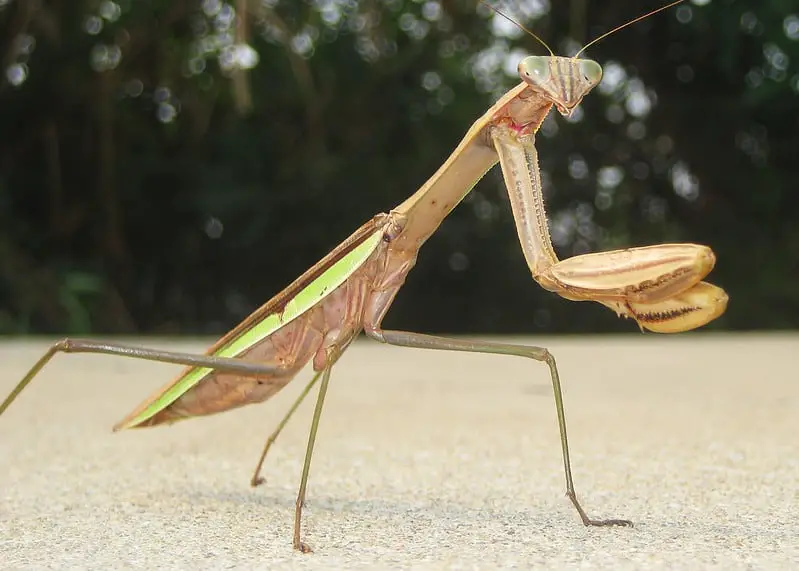
The Chinese Mantis typically lives for 8 to 12 months in captivity. It’s quite easy for them to reach their full lifespan in captivity because there are not many things that threaten them. The only things that can really pose a threat to them are bacteria, mold, parasites, and humans.
To keep your Chinese Mantis healthy, it’s important that you give them feeder insects that are captive-bred. Wild-caught insects often contain parasites that can be transferred to your mantis.
In addition, adequate ventilation in their enclosure is important to avoid the buildup of bacteria and mold. For that reason, it’s also important that you remove uneaten food in a timely matter.
Lastly, if you choose to handle your mantis it is important that you do so carefully. They’re quite fragile insects that can easily be crushed accidentally. Especially right after a molt when their exoskeleton has not had time to harden yet they are very vulnerable.
Fun Facts about the Chinese Mantis
- Even though most Mantids are prone to cannibalism, the Chinese Mantis is more inclined than other members of its family. Cannibalism occurs in 50% of every mating attempt, in which the female will often eat the male’s head during the act.
- As its name implies, the Chinese Mantis isn’t native to North America. This species was introduced into the United States by mistake in 1896 by a nursery person. As of today, the Chinese Mantis is one of the most common Mantids in the USA.
- Popular culture surrounding the Mantids is that they’re called Praying Mantis. This is wrong, as they should only be called Mantis (Mantids in plural). They’re called Praying Mantis for holding both front legs in front of their bodies as if they were praying.
- The largest Mantis ever found was a Chinese Mantis found in Southern China in 1929. The specimen was 7 inches (18 cm) long!
Final words: Is the Chinese Mantis Right for You?
The Chinese Mantis is the perfect entry point if you’re looking to add Mantids to your collection. It’s beautiful, easy to care for when they’re adults, and an exciting eater. In addition, they’re quite large, which makes them very interesting to watch. Even if you’re not a beginner and already have some experience with keeping insects, the Chinese mantis is still a great addition to any insect collection!
If you’re interested in learning more about these fascinating insects, the Carolina Mantis might be a species you’d want to check out!
- How Long Do American Eskimo Dogs Live? Important Factors and Care Tips - September 29, 2023
- Do American Bulldogs Need Grooming? Essential Tips and Care Guidelines - September 29, 2023
- Do Bengal Cats Enjoy Playing? Essential Tips for Keeping Them Active - September 29, 2023